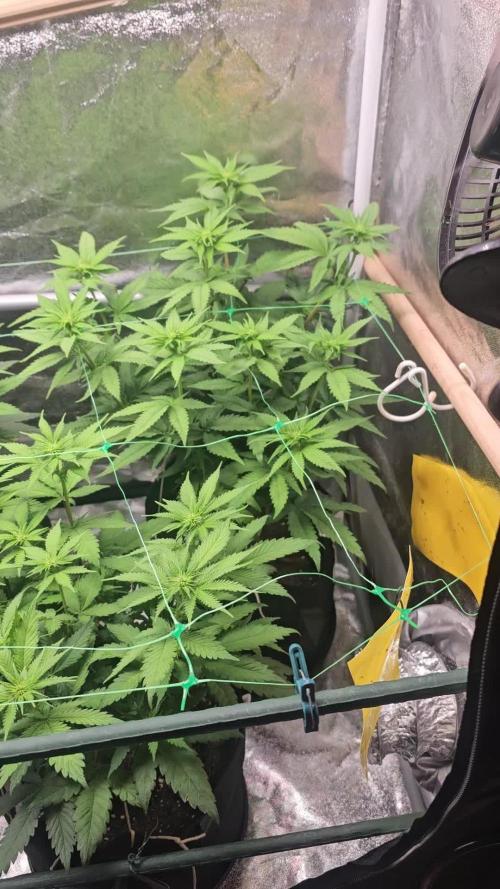The Grow Awards 2026 🏆 







































Likes
Comments
Share


@GelatoTerps
Follow
Deep watering on Sundays (buildaflower compost tea)
Moist watering on Wednesdays ( vitamin c water & jay plantspeaker )
Cut down 3 hermies from light leak
2 charmz
1 Apple fritter
Likes
99
Share


@BudXs
Follow
Healthy all around with the exception of one auto that got too frequent of a watering, resulting in N buildup. No worries, quick fix, and she'll have suffered little stress in the grand scheme of it all.
Mothers looking vibrant af. First set of clones to be taken on May 1st, then a second set a few days later. Mothers will then be gifted to outdoor growers.
One auto will be sprayed with colloidal silver next week to induce pollen for future auto crosses.
Two mothers will be kept in a separate roof to get silver spray as well, the resulting pollen to cross with this years 2 phenos to create 2021 fems
Likes
22
Share


@BlumenBot
Follow
4/3 - she is taking her sweet ass time gaining height and I'm getting bored with this grow at this point. I'm going to defoliate every other branch completely to the top to see how those differ from the ones that I leave more or less alone from this point forward. She is taking on a lot of water, every other day is a must.for?
4/6 - she got fed yesterday and needed more water today, she's showing a tiny bit of nutrient burn so I will be keeping it easy for a bit, I also chopped a lot of foliage out. Only the tops left and preflowers showing everywhere
4/8 - thirsty lady
4/9 - more water! Added cal/Mag, 6.2ph now, she's got something going on
Likes
6
Share


@midnitrtoker
Follow
The time has come!!!! I was gonna give it a couple more days but I’m too antsy and want to get this girl drying already. I will be cutting her down at the end of today she has been getting straight water these past week she isn’t getting any color just yellowing of the leaves. She smells minty when defoliating but the buds smell skunky and dank asf. Light green buds remind me of old school weed I used to smoke in HS shits amazing.
Likes
9
Share


@Serhiosaez
Follow
Floracion las planta que estaba amarilla se esta recuperando anda mucho mejor pirde menos hojas y las demas siguen en perfecto estado
Likes
8
Share


@Roberts
Follow
Fast version B is doing good. She is just vegging along. She should be showing her maturity here in the coming weeks. Then we can get her to a flowering room when it's open. Thank you Dutch Passion, SSSC, Medic Grow, and Athena. 🤜🏻🤛🏻🌱🌱🌱
Thank you grow diaries community for the 👇likes👇, follows, comments, and subscriptions on my YouTube channel👇.
❄️🌱🍻 Happy Growing 🌱🌱🌱
https://youtube.com/channel/UCAhN7yRzWLpcaRHhMIQ7X4g.
Likes
11
Share


@TiRobotProds
Follow
Cela es ma deuxième session automatique et je peut dire que Cette plante est incroyable, magnifique grandit vigoureusement plein de pistils 🎄🎄
La température est de 26°🌡️ pour 55% d'humidité🌅, sur les photos vous pouvez voir une carence en potassium pour cela j'ai commencé à engraisser au Méga PK 50-33 voyons dans les semaines à suivre si cela s'aggrave merci a toi de m'avoir lu bonne croissance a tous.
Likes
Comments
Share


@Ctrellis90
Follow
So here we go!
Another start to something special and another grow off! Always fun.
Anyways we have two Pablo's that both popped up through the soil and are on their way. I'm very Interested in seeing how well these genetics perform. They definitely came a long way from overseas so let's see how well the foreign competition is 😉. If their on GD I'm sure they're fire.
Likes
2
Share


@GanjOS_OG
Follow
We picked up the cuttings for the GanjOS Lab from High4Life on December 30th and put them in our propagator for around 3 days for acclimatization.
Processing
Likes
6
Share


@Ferenc
Follow
All good flowers are coming along nicely and getting thicker. 500ml water per day 12/12, fertilization happens on Monday, Wednesday and Friday with the mix above. All good so far I just keep removing the bottom leaves that are yellowish. Fruit Tree will be the quickest to be harvested all of them are nicely maturing needs some more time. Some more weeks and we will see.
Likes
10
Share


@FrulaFrulaki
Follow
Almost one week of flushing and they’re showing signs. It smells full on like apples in the box and the buds themselves have an amazing smell. I think that they’ll be done in a week so keep posted.
Processing
Likes
3
Share


@I_roll_my_own_420
Follow
Buds are getting heavy, I had to craft a net to hold them up. All smells fantastic, looking good.
Likes
7
Share


@SomeLikeItGrow
Follow
The week was crazy, a lot of height growth that is bad, because i don’t have it, but overall looks good and let’s see what will come, hard defoliation has been done, hope last one ;p
Likes
56
Share


@KingSalomonsWeed
Follow
Das war ein aufregender Lauf. Problemlos, aber aufregend sexy.
So ab Blüte fühlte es sich an wie das Video. Aufregend, Anziehend.
Das ist total geiles Weed!
9 Punkte
Sehr Empfehlenswert für Feinschmecker, die wenig Zeit haben.
Und trotzdem ne starke Brise um die Ohren gehauen bekommen wollen.
03. Februar
Oh Jungs?
Knallt gut!
Schmeckt gut!
SWEET SEEDS, SUPERSORTE!
06. Februar
Munchies und ein tiefer zufriedener Schlaf inklusive. " GEIL "
Likes
8
Share


@All_our_small_plants
Follow
Bewässerung: 500 ml jeden 3 Tag in der Fünften Woche
pH-Wert: 5,8
EC-Wert: 0,4 mS/cm
Temperatur: 30ºC
Luftfeuchtigkeit: 50%
Schädlingsbekämpfung: im Moment haben wir keine Anzeichen von befall wir haben nur mal zur Prävention etwas Sand gegen die Schnecken um die Pflanze gemacht, dies verhindert das diese sich nähern.
PPFD: Direktes Sonnenlicht
DLI: Direktes Sonnenlicht
Besonderheiten: Sind in kleinen Töpfe gepflanzt und werden diese Woche in den Boden gesetzt.
-Tag 29 Heute wurden Beide in den Boden Gesetzt und wurde mit Sand umrandet. Das dient dazu das sich keine Schnecken nähern, zusätzlich haben wir sie mit einem kleinen Zaun umrandet damit sie unser Tiger nicht gleich entlaubt 🙀 sehen beide soweit gesund aus.
-Tag 31 beide haben die Verpflanzung in die Erde überlebt 😍
Likes
7
Share


@Lazuli
Follow
This is the only plant ever that was ready in 10 weeks from seed im so proud hahaha
Likes
74
Share


@Mr_Maes
Follow
This week we will see the colas and buds really dense up. We are about 2 weeks away from harvest now. Next week I will start my flush.
Likes
6
Share


@88kasanova
Follow
Man!!!! I did not expect some bag seeds to be as successful as these, but the seeds I got came from bud I got from the dispensary, my one gallon DWC experiment is great!! It’s not huge but it’s the most potent!! And I did one plant base nutes only and another with all the additives.. the the plant with base nutes only is the biggest!!
Likes
3
Share


@FlowerOasis420
Follow
Sie gehen gut in den Stretch und legen gut an Höhe zu. Die ersten Blüten bilden sich aus.
Likes
27
Share


@MrJones
Follow
OSS Cheese XXL
🔹⊱╮🔹╰⊰🔹 GROW Started 03.10.24 INFORMATION 🔹╰⊰´🔹⊱╮🔹
🌞Environment - Maintaining 80F and 65%Humidity
🌾Training - These ladies are Pruned and Defoliated and ready for flower.
⚱️2-Gallon 📊6.2 PH
💧 Feeding - Using Horti Grow 8-11-21, Bloom 5-15-26, Late Bloom 0-24-26, Cal 12-0-0
🌞Medic Grow Smart 8 760 Watts
🕷️ IPM - CannControl from Mammoth and Mosquito Bits as needed
🔹⊱╮🔹╰⊰🔹 GROW Started 03.10.24 INFORMATION 🔹╰⊰´🔹⊱╮🔹
🌞Environment - Maintaining 80F and 65%Humidity
🌾Training - The girls are recovering from last week's Pruning and Defoliation,
⚱️2-Gallon 📊6.2 PH
💧 Feeding - Using Horti Bloom and Horti Cal 12-0-0
🌞Medic Grow Smart 8 760 Watts
🕷️ IPM - CannControl from Mammoth and Mosquito Bits as needed
🔹⊱╮🔹╰⊰🔹 PLANT UPDATES 🔹╰⊰´🔹⊱╮🔹
📝 Notes - On 🗓️05.11.24, This week, we are on Auto-Pilot and just Fertigating as needed; the ladies are stacking up nicely, and the leaves have grown back not sure if it is the genetics or the new nutrients; I would like to see less and will evaluate if more defoliation will be needed.
📝Fertigation injects fertilizers into an irrigation system to supply dissolved nutrients to crops.
🗓️05.11.24 Just feeding daily, sometimes twice; today, fed with Hort-Bloom @ 2.7 GRMS Per Gal and Horti-Cal @ 2.5 GRMS Per Gal.
🗓️05.12.24 Just feeding daily, sometimes twice; today, fed with Hort-Bloom @ 2.7 GRMS Per Gal and Horti-Cal @ 2.5 GRMS Per Gal.
🗓️05.13.24 Just feeding daily, sometimes twice; today, fed with Hort-Bloom @ 2.7 GRMS Per Gal and Horti-Cal @ 2.5 GRMS Per Gal.
🗓️05.14.24 Just feeding daily, sometimes twice; today, fed with Hort-Bloom @ 2.7 GRMS Per Gal and Horti-Cal @ 2.5 GRMS Per Gal.
🗓️05.15.24 Just feeding daily, sometimes twice; today, fed with Hort-Bloom @ 2.7 GRMS Per Gal and Horti-Cal @ 2.5 GRMS Per Gal.
🗓️05.16.24 Just feeding daily, sometimes twice; today, fed with Hort-Bloom @ 2.7 GRMS Per Gal and Horti-Cal @ 2.5 GRMS Per Gal.
🗓️05.17.24 Just feeding daily, sometimes twice; today, fed with Hort-Bloom @ 2.7 GRMS Per Gal and Horti-Cal @ 2.5 GRMS Per Gal.
╰⊰🔹╰⊰´🔹⊱╮🔹╰⊰🔹╰⊰🔹STRAIN INFORMATION🔹⊱╮🔹╰⊰🔹╰⊰🔹╰⊰🔹⊱╮
Cheese XXL cannabis seeds are a unique blend of Afghan Kush x Super Skunk, producing the most pungent dank weed. Cheese XXL is the third commercially available edition released by Original Sensible using and developing these Afghan and Skunk genetics. The first release of these genetics was their Skunk Afghani. The second improved version was Stinkin' Bishop, which had an enhanced and more potent THC content and was more intense in terms of smell. The third and improved release on a similar theme is this Cheese XXL, which has a similar THC content but an enhanced heavier yield. The smoke is incredible, with an outstanding flavor of pungent skunk and spicy, extra strong mature cheese created by the dominant terpene myrcene with its earthy solid scent accompanied by caryophyllene and pinene, which combine to create a peppery acrid cheesy odor. THC levels are exceptionally high in this Cheese strain, and the effect is well-balanced, developing mental and body relaxation with a remarkable alleviation of stress and depression.
The intense solid aroma starts early in the flowering period; if you're growing Cheese XXL indoors, you'll need plenty of ventilation to disperse these babies' stinky "road kill" aroma! Cheese XXL is a cheese strain suited to indoor setups and thrives outdoors well. These feminized marijuana seeds are incredibly resistant to mold and disease and produce a substantial harvest that professional and amateur growers can quickly achieve. These Cheese weed seeds are outstanding. Break open the buds ready for use, and you'll see why the stench will make your eyes water!
Cheese XXL from Original Sensible Seeds is a great choice to break into the commercial market of growing cannabis, so if you're looking to buy something special with extreme yield, potency, and flavor, Cheese XXL cannabis seeds are simply the best choice.


















